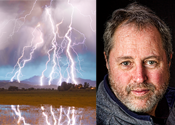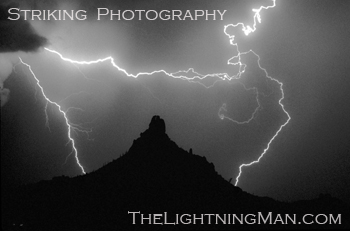| CLOSE UP |
The Valley can be a magnet for lightning and lightning chasers during
the monsoon season. Local photographer Jacobo “Bo” Insogna
captured this image of lightning strikes in North Scottsdale.
Photo by Jacobo “Bo” Insogna/Special to
Independent Newspapers
STRIKE ZONE
Published:
Jul 23, 2003 – 10:20:02 AM MDT Wendy Miller / Independent
Newspapers
www.NewsZap.com (C)
allrights reserverd
Lightning energizes nature photographer
By Wendy Miller/Independent Newspapers
It was the one time Jacobo Insogna dared Mother Nature.
Lightning was striking all across the McDowell Mountains in North
Scottsdale. Rain started to fall, heightening the risk factor.
The opportunity to capture frenzied bolts of energy over the bronze
horses at WestWorld had eluded the freelance photographer for two long
years, but on this rainy night, all the elements were in place to get the
long-awaited shot.
“When I first saw the horses, they looked like lightning had hit and
they were rearing,” said Mr. Insogna, who goes by “Bo.”
“I waited and waited and one night it was right.”
Grasping his 35mm Pentax camera with a 50mm lens, he traveled up Pima
Road. This was before Highway 101 had opened through the area. There was no
traffic so he was able to position himself in the middle of the street.
“It started to rain and here I was in the water with a metal tripod
and the lightning is hitting 100 feet away,” he said, “so I got
the shot and got out.”
Mr. Insogna is one of a handful of professional photographers who get
paid for chasing lightning. He moved from Boulder, Colo. to Arizona in 1987,
after a downturn in Colorado’s economy put a bite on his horse photography
business.
(C) 2003 Jacobo Insogna www.ArizonaLightning.com
all right reserved
Sculpture by Snell Johnson
The outdoorsman was lured here by the opportunity to photograph the
Arabian horse market. However, he was quickly enamoured with the quick
weather changes and spectacular night shows produced by lightning during
monsoon season.And there are plenty of evening lightning shows to view. Arizona is
second in the nation for the number of lightning strikes recorded. Florida
is number one.From July to September-Arizona’s monsoon season-photographers like Bo
Insogna are in their glory capturing the bolts of white and yellow as they
rip across the night skies. But Mr. Insogna also has seen the damage such
high velocity beauty can produce.“Rain can come in with such force that you get stuck and can’t get
out,” he said. “Mother Nature is nothing to play with. With each
storm, it seems I see someone in a car floating up to their windows in
rain.”Danger comes not only from rain but also from the lightning itself.
“One time at Pinnacle Peak, the lightning shot sideways,” Mr.
Insogna remembered. “It’s an eerie feeling when you’re shooting and all
the hairs on your body stand up. There’s a smell, an odor as the static
charge builds. You can tell something is going on but it’s not a good thing,
so you get out.”The beauty of northeast desert keeps the photographer coming back.
“North Scottsdale is very pretty, especially all the saguaros, and
there is easy access to many of these places,” he noted. Freeways, such
as the 101, provide him with a bird’s eye view of the higher elevations.But it’s the lightning that really energizes him.
“Sometimes the storms come in like a rocket,” Mr. Insogna said.
“The monsoon season comes in like clockwork every year, but the
lightning is unpredictable. I’ve seen it go from the sky to the ground,
horizontally across the sky, and in balls of fire.“The lightning hits the highest points,” he continued.
“Sometimes the heat from the mountains seems to attract it; I’ve seen
it jump between mountaintops. Other times it hovers over certain
areas.”The dedicated photog has two choices when a lightning storm is sighted.
He can position himself in a prime location and wait for the lightning to
come to him. Or he can chase it.“It depends on whether I’m trying to get a specific shot or if I’m
doing some general lightning chasing,” he said. “I try to have
some locations set up ahead of time that would look good as backgrounds for
lightning.”Sometimes he just sits back and admires the view.
“I’ve watched a storm just walk down the mountains,” Mr.
Insogna said. “I’ve seen the lightning light up the crevice of the
mountains and illuminate incredible plants and animals.”But he also has tremendous respect for the power of a storm and takes
precautions to protect his camera equipment-and his body-from harm.“Safety is number one,” he said. “Once you put yourself in
the area of a lightning storm, you could be struck.”Mr. Insogna wears rubberized shoes because leather can conduct
electricity from the lightning. Rain gear is a must to protect his camera
from the rain. And he stays close to his vehicle.“A car is always the safety zone,” he said. “Stay inside
until the storm rolls through. The rubber tires will protect you.”Typically, the monsoon season has officially begun by July 7. This year,
lightning chasers like Bo Insogna are itching to press their camera trigger
finger.“I’m always looking for something spectacular,” he said.
Tips on Photographing Lightning
Photographer
James “Bo” Insogna has
spent many years photographing lightning over North Scottsdale and other Valley locations. He shared the following tips on how to capture the images on film.
Watch the weather. Be prepared and ready to go if a storm is moving toward your area.
- Safety is of utmost importance. Don’t put yourself in
danger. You or your tripod could be the high point lightning
is seeking to strike. If you’re in the middle of the desert
and find yourself in danger, retreat to your car. Remember,
with its four rubber tires, your car provides a safe zone.
- Wait and anticipate. Pick a location you feel would make a
scenic background, then set up your equipment. Don’t be
discouraged if you don’t get the shot you want. It took Mr.
Insogna two years to get the cover shot at WestWorld.
- Chase the lightning. You may not get the background you
wanted, but you’ll have more chances of photographing Mother
Nature’s brightest moments. Sometimes lightning happens all
around you. Take advantage of it.
- Use a tripod and shutter cable for timed shots.
- Timed exposures can require camera shutters to be open
from a couple seconds to a minute. The key is to watch where
lightning is hitting, then count from 1 to whenever it hits
again. Do this for several strikes. If you recognize regular
intervals, open your shutter before the lightning strikes
again.
- Use slower films that are less grainy than their faster
counterparts. Look for 64 or 100 ASA (film speed)
transparency films. These can be enlarged with greater
clarity.
Related Post:
Budweiser Brewery Ft Collins Colorado Lightning Strike Video
Lightning man strikes Boulder County
Striking Photography -Yippy Yi Yea Magazine
The Lightning Man, Bo Insogna on TV 3
James “Bo” Insogna, “The Lightning Man” Striking Photography featured on ABC News TV 15
James Bo Insogna – The Lightning Man – Striking Photography







[…] STRIKE ZONE – Lightning energizes nature photographer […]
STRIKE ZONE – Lightning energizes nature photographer | The Lightning Man – Lightning Photography Images – just great!